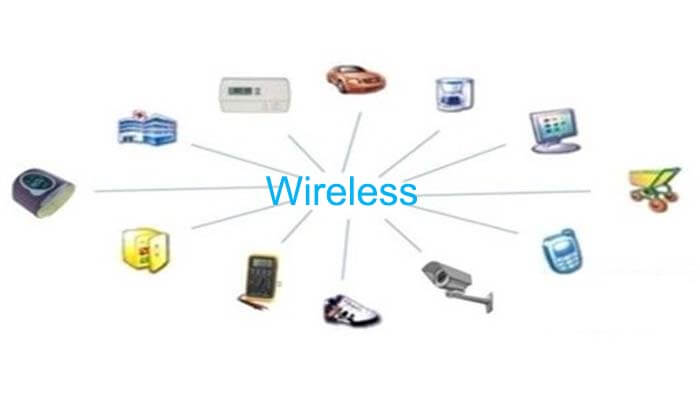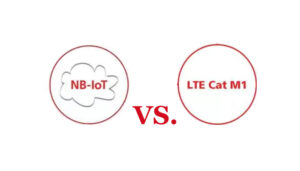Here are the 12 kinds of wireless technologies. Who will become the main theme of the Internet of Things?
The Internet of Things, all things are connected. In this era, more and more objects will be connected to the Internet, and finally, realize the connection to the host/cloud. These connections, we can use a variety of communication links to achieve.
However, the device itself is generally connected to the Internet of Things system wirelessly. This wireless connection is the most important or weakest link in the system. Therefore, it is important to choose a wireless technology that can match the device and its surrounding environment. This article describes several wireless candidate technologies that are most likely to be adopted for new designs.
The device is connected to the gateway wirelessly is a typical IoT connection scenario. A gateway is an interface that connects to the Internet through a public broadband cable or DSL modem and then connects to the Internet through an Internet service provider.
In another application scenario called machine-to-machine (M2M), the device connection will go through a cellular operator, and then to another operator, or directly to the Internet.
Many design factors must be carefully considered when choosing a wireless technology:
The data rate of the device: video streaming, temperature measurement per minute, or other parameters in between.
Range or distance to the gateway: A few inches in a room, or more than 1 mile in a rural area.
Environment: Dangerous environment in the factory, outdoor environment exposed to the weather, noise or electromagnetic interference from electronic equipment, etc.
Encryption or authentication required: What are the requirements for data security?
Power consumption: battery life, energy efficiency, and AC power connection may be required.
Capacity: The number of networked devices.
Service quality and reliability.
Network topology: star, mesh, or other topologies.
Simplex or duplex: One-way or two-way communication.
Suitable and available spectrum: licensed or unlicensed.
Available ICs, modules, and equipment.
Cost: Design, manufacturing, or Internet access service fees.
Development platform: Do you need an operating system? What other software is needed?
Internet access: cellular, digital subscriber line (DSL), cable, satellite.
Standard license conditions are available.
2G/3G cellular technology in wireless technologies
Many use cases commonly referred to as machine-to-machine (M2M) are similar to the Internet of Things. Many vendors provide cellular phone modules for embedding into other products, and most major cellular operators provide M2M connection services on a standard licensed spectrum. Although 2G technologies such as GSM/GPRS/EDGE are very popular, some operators have plans to phase out 2G services.
However, most networks still support 3G technologies such as WCDMA and CDMA2000, with data rates up to several megabits per second. Range refers to the distance to the cell site, which can be as long as several kilometers. The cellular connection is obviously an option, but it is more expensive than the other solutions described later.
802.15.4 technology in wireless technologies
802.15.4 targets short-range, low-to-medium data rates, and low-power use cases, and is the basis for several other standards mentioned later. Its main operating frequency spectrum is the 2.4GHz industrial, scientific, and medical (ISM) unlicensed frequency band, and sometimes the 902MHz to 928MHz and 868MHz frequency bands are also used.
The 802.15.4 standard provides packet-based protocols for the PHY and MAC network layers. Other standards are based on this to add more layers, thereby providing enhanced network functions and performance.
6LoWPAN address node technology in wireless technologies
The 6LoWPAN of the International Internet Engineering Task Force (IETF) is the abbreviation of Internet Protocol Version 6 (IPv6) based on low-power wireless personal area networks.
The original target of this standard was 802.15.4, which was later adopted by Bluetooth Smart and low-power HaLow Wi-Fi. Specifically, 6LoWPAN defines a way to adapt IPv6 data packets into other protocol frames using encapsulation and header compression techniques.
Bluetooth technology in wireless technologies
Perhaps the most widely used short-range wireless technology is Bluetooth (BT) operating in the 2.4GHz ISM band. Several different versions provide a variety of different data rates, power levels, and ranges. Its basic working principle is the frequency hopping spread spectrum (FHSS) technology using different modulation methods.
The latest version of Bluetooth is Bluetooth Smart or version 4.1, also known as Bluetooth Low Energy (BLE). This configuration uses shortened data packets, the maximum rate is 1Mb/s, and GFSK modulation is used.
Its biggest advantage is its excellent low power consumption characteristics. The transmission power is 10mW, and its distance can reach 100 meters. There are a variety of software configuration files for different purposes, and its interoperability certification can effectively achieve full compatibility.
Lora technology in wireless technologies
Lora (Long Range) is a technology developed by Semtech. The typical operating frequency is 915MHz in the United States, 868MHz in Europe, and 433MHz in Asia. Lora’s physical layer (PHY) uses a unique form of FM chirp spread spectrum technology with forwarding error correction (FEC).
This spread spectrum modulation allows multiple radio devices to use the same frequency band, as long as each device uses a different chirp and data rate. Its typical range is 2km to 5km, and the longest distance can reach 15km, depending on the location and antenna characteristics.
LTE Cat 0/1 technology in wireless technologies
LTE is the abbreviation of Long-Term Evolution and is the current fourth-generation cellular technology.
LTE Cat 0 and Cat 1 are simplified versions of LTE functions and are specially designed to match the low power consumption and low rate requirements of M2M. M2M applications are also known as machine-type communications (MTC) and use existing cellular networks in the licensed spectrum instead of short-range wireless and the Internet.
For most basic monitoring and control applications, standard LTE networks are too wasteful. LTE Cat 0 and Cat 1 are simplified versions that can provide suitable solutions for M2M applications with maximum data rates of 1Mb/s and 10Mb/s, respectively.
Cat 0 and Cat 1 use existing LTE bandwidth and Orthogonal Frequency Division Multiple Access (OFDMA) modulation technology. This long-distance solution can support a range of several kilometers.
Narrowband Internet of Things (NB-IoT) technology in wireless technologies
A relatively new variant of using LTE for the Internet of Things is the narrowband Internet of Things. Unlike the full 10MHz or 20MHz bandwidth using standard LTE, the narrowband IoT uses a 180kHz wide resource block containing 12 15kHz LTE subcarriers. The data rate is in the range of 100kb/s to 1Mb/s.
This more simplified standard can provide very low power consumption for networked devices. In addition, it can be deployed into an LTE network as a software overlay. The resource blocks of NB-IoT can be well adapted to standard LTE channels or guard bands.
When operators re-divide their earlier 2G spectrum, it can also adapt to standard GSM channels. The modulation uses OFDMA downlink and SC-FDMA uplink.
SigFox technology in wireless technologies
SigFox is both wireless technology and a network service. SigFox works in the ISM frequency bands of 868MHz and 902MHz but consumes very narrow bandwidth or power consumption.
SigFox radio equipment uses a technique called ultra-narrowband (UNB) modulation, which only occasionally transmits short messages at low data rates. The maximum length of a message is 12 bytes, and the maximum number of messages that a node can transmit per day is 140.
Due to the narrow bandwidth and short messages, in addition to its 162dB link budget, it can also reach a long transmission distance of several kilometers.
Weightless technology in wireless technologies
Weightless is a series of open wireless technologies standards targeting IoT applications. It has three different versions, corresponding to different segments in the LPWAN market.
The simplest version is Weightless-N for low-cost applications. The goal of this version is simplex or one-way use, such as sensor monitoring. It works in the license-free ISM frequency band of less than 1 GB.
The modulation uses differential BPSK using frequency hopping technology to minimize interference. 128-bit AES encryption with a complete signature function is a key feature of this technology. Due to the low data rate and narrow bandwidth channel, the transmission distance can reach up to 5km.
If higher-performance two-way communication is required, Weightless-P may be the best choice. It uses both frequency division multiple access (FDMA) and time division multiple access (TDMA) technologies to manage and access multiple 12.5kHz wide channels.
This technology uses GMSK and interleaved QPSK modulation, and the data rate can range from low-speed 200b/s to 100kb/s. The typical maximum transmission distance is about 2km. In terms of security, it supports AES-128/256 encryption and signing authority.
The third version is Weightless-W, designed to work in the white space of the TV. White space is those 6MHz wide channels previously used by television stations in the 470MHz to 790MHz range.
It can reach data rates from 1kb/s to 10Mb/s, depending on the link budget. The farthest transmission distance can reach more than 5km under non-line-of-sight conditions.
Wi-Fi technology in wireless technologies
Wi-Fi is widely used in many IoT application cases, most commonly as a link from a gateway to a router connected to the Internet. However, it is also used for major wireless links that require high speed and medium distance.
Most Wi-Fi versions work in the 2.4GHz unlicensed frequency band with a transmission distance of up to 100 meters, depending on the application environment. The popular 802.11n speed can reach 300Mb/s, and the newer 802.11ac, which works in the 5GHz ISM band, can even exceed 1.3Gb/s.
A new version of Wi-Fi suitable for IoT applications called HaLow will be launched soon. This version is code-named 802.11ah and uses the license-free frequency band from 902MHz to 928MHz in the United States, and other countries use similar frequency bands below 1GHz.
Although most Wi-Fi devices can only reach maximum coverage of 100 meters under ideal conditions, HaLow can reach as far as 1 km with a suitable antenna.
The modulation technology of 802.11ah is OFDM, which uses 24 subcarriers in a 1MHz channel and 52 subcarriers in a larger bandwidth channel. It can be BPSK, QPSK, or QAM, so it can provide a wide range of data rates.
Another new Wi-Fi standard for IoT applications is 802.11af. It is designed to use TV white space or unused TV channels in the range of 54MHz to 698MHz. These channels are very suitable for long-distance and non-line-of-sight transmission.
The modulation technique is OFDM using BPSK, QPSK, or QAM. The maximum data rate of each 6MHz channel is about 24Mb/s, but it is expected to achieve longer distances in the lower VHF TV band.
WirelessHART technology in wireless technologies
This is a wireless version of the widely used high-speed addressable remote sensor (HART) industrial network technology in wireless technologies, which is mainly used in process monitoring, sensor networks, building automation, and transportation. The technology is based on the popular IEEE 802.15.4 standard, code-named 802.15.4e.
WirelessHART adds a time synchronization grid protocol to the basic standard. In addition to the grid topology, it can also adopt a star configuration. WirelessHART uses TDMA and Time Slot Hopping Channel (TSCH) technology, which can visit up to a node.
ZigBee technology in wireless technologies
ZigBee is one of the ideal choices for the Internet of Things in wireless technologies.
Although ZigBee generally works in the 2.4GHz ISM frequency band, it can also be used in the 902MHz to 928MHz and 868MHz frequency bands. The data rate in the 2.4GHz band is 250kb/s. It can be used in point-to-point, star, and grid configurations and supports up to 216 nodes. Like other technologies, security is guaranteed by AES-128 encryption.
One of the main advantages of ZigBee is that there are pre-developed software application profiles for specific applications (including the Internet of Things). The final product must be licensed.
Z-Wave technology in wireless technologies
Z-Wave is a single-source proprietary technology in wireless technologies. Work in the ISM frequency band of 908.42MHz. It uses high-efficiency GFSK to achieve a data rate of 9600b/s or 40kb/s; in some applications, it can even reach 100kb/s. The typical power level is 1mW (0dBm), and the maximum coverage is about 30 meters, depending on the specific application environment.
Z-Wave can be used in point-to-point links or star configurations with up to 232 nodes. In terms of security, it uses AES-128 encryption measures. This technology must be licensed before it can be used in commercial products.
From this table in the article, we can quickly compare the 12 technologies mentioned in the article. At the same time, the Internet of Things market is all-encompassing, involving various industries such as industry, transportation, agriculture, and medical care, with different application requirements.
For a long-tail market like the Internet of Things, we can be sure that no standard will dominate. However, we can easily find the most appropriate wireless technology-specific applications.
Besides the 12 Kinds of Wireless Technologies article, you may also be interested in the below articles.
5G NR Communication Technology And Characteristics




